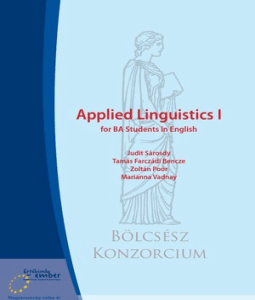Reviewed by Zaenal Arifin
Tulungagung, 3 October 2013
Judit Sarosdy, et al. Applied Linguistics I for BA Students in
English
Applied Linguistics
The key term that we need to
understand before going further discussing this book is ‘applied linguistics’.
According to Péter
Medgyes the discipline ‘applied linguistics’ has got several interpretations.
Some specialists mean language pedagogy by ‘applied linguistics’, while
others integrate all new linguistic disciplines such as psycholinguistics,
sociolinguistics, pragmatics, and/or computer assisted
linguistics into the term.
About
this Book
Applied
linguistics meant in this book is that from the first definition which deals
with language pedagogy. From what I read on it, I myself conclude that this
book is originally designed for university students studying English teaching,
as also stated in the book that the writers’ aim with the present work is to
arouse BA students’ interest in Language Pedagogy and motivate them to become
English teachers. They will have plenty of chances to gain deeper knowledge in
each area of Applied Linguistics.
Judit and
friends, in this book, try to provide wide information about English pedagogy,
including various teaching methods, learning process and learning types, classroom managements, exploration of language
skills and aspects, course planning, evaluation with
its deep explanation, and others. Take an example about language skills in this book, it
begins with the explanation of language teaching models, giving readers
understanding about input and output, then developed into the classification of
language skills (receptive and productive), plus the exploration of the skills
such as why they are important, and some views of sub-skills, like skimming,
scaning, interpreting and so on in reading and/or listening skill.
Contents
See the ‘contents’ below for complete description.
FORMER
METHODS IN TEACHING ENGLISH
1.1. The
Grammar Translation Method
1.2. The
Direct Method
1.3. The
Audio-Lingual Method
1.4. The
Silent Way
1.5.
Suggestopedia
1.6. Community
Language Learning
1.7.
Total Physical Response (TPR)
THE
COMMUNICATIVE APPROACH
2.1.
Communication
2.2.
Characteristics of communicative classes
2.3.
Defining Communicative Competence
PARTICIPANTS
OF LEARNING PROCESS
3.1.
Teacher’s roles, teaching styles
3.1.1. Controller
3.1.2. Organiser
3.1.3. Assessor
3.1.4. Prompter
3.1.5. Participant
3.1.6. Resource
3.2.
Learner types
3.2.1.
The Age of Learners
3.2.2.
Learner differences
3.2.2.1.
Neuro-linguistic programming – Revell and Norman (1997)
3.2.2.2. Multiple
intelligences theory – Gardner (1983)
3.2.2.3. Learning styles
according to Willing (1987)
CLASSROOM
MANAGEMENT
4.1.
Classroom interaction
4.2.
Classroom dynamics
4.3.
Classroom arrangement – various work-forms in classes
4.3.1.
Whole class grouping (Frontal/Lockstep)
4.3.2. Individualised learning
4.3.3. Pairwork
4.3.4. Groupwork
4.4.
Discipline problems
4.4.1. Discipline
4.4.2.
Why discipline problems occur
4.4.3.
The teacher’s role in maintaining discipline
4.4.3.1.
How to prevent disruptive behaviour
4.4.3.2.
Dealing with the rising problems
4.4.3.3.
When the problem has exploded
4.5.
Classroom management techniques
4.5.1. Techniques
LANGUAGE
SKILLS
5.1. A
language teaching model
5.1.1. Input
5.1.1.1. Roughly-tuned
Input
5.1.1.2.
Finely-tuned Input
5.1.2. Output
5.1.2.1. Practice output
5.1.2.2. Communication output
5.2.
Classification of language skills
5.2.1.
Receptive Skills
5.2.1.1.
Reasons for reading and listening
5.2.1.2.
Sub-skills of Receptive Skills
5.2.1.3. Methodological
Principles for Teaching Receptive Skills
5.2.1.3.1.
The content of the texts
5.2.1.3.2.
Methodological Steps of Developing Receptive Skills
5.2.2.
Productive Skills
5.2.2.1. Speaking
5.2.2.2. Writing
5.2.2.3. Translation
5.2.2.4. Interpreting
VOCABULARY
6.1.
Selecting Vocabulary
6.2. What
does it mean to know a word?
6.3.
Active and Passive Vocabulary
6.4.
Presenting Vocabulary
6.5.
Using dictionaries
GRAMMATICAL
STRUCTURES
7.1. The
presentation of structures
PRONUNCIATION
8.1. When
to teach pronunciation?
8.2. The
areas of pronunciation
8.2.1.
Individual sounds
8.2.2.
Stress
8.2.3.
Intonation
8.2.4.
Connected speech and fluency
8.3. What
materials to use to improve students’ pronunciation?
CULTURE
IN TEACHING ENGLISH
9.1. The
definition of culture
9.2. The
domains of culture
9.3. What
culture do we teach?
9.3.1.
The importance of teaching achievement culture (‘big C’)
9.3.1.1.
The objectives of teaching achievement culture
9.3.2.
The importance of teaching behaviour culture (‘small c’)
9.3.3.
The concepts belonging to the third area of culture
9.4. Why
to teach culture?
9.5.
Goals of teaching culture
VISUAL,
AUDIO, AUDIO-VISUAL AND DIGITAL AIDS
10.1.
Basic principles of using tools in foreign language classes
10.2.
Visuals and techniques of visualisation
10.3.
Audio resources and ways of audio-production
10.4.
Audio-visual means of education and approaches to video-production
10.5.
Information and communication technologies
PLANNING
11.1.
General principles of course design
11.2.
General principles of syllabus design
11.2.1.
Planning a syllabus
11.2.2.
Types of syllabuses
11.3.
Short-term planning – Lesson plans
11.3.1.
Pre-planning
11.3.2.
The plan
11.3.3. A
sample lesson plan
FEEDBACK
AND ERROR CORRECTION
12.1.
Feedback
12.2.
Kinds of feedback
12.3.
Error correction
12.4
Errors versus mistakes
12.4.1.
Mistakes
12.4.2.
Slips and attempts
12.4.3.
Performance versus competence
12.4.4.
Errors
12.5. Teachers’ attitude
to errors
12.5.1.
Interlanguage
12.6.
What are the most important causes of errors?
12.6.1.
Language transfer - interference
12.6.2.
Intraference
12.6.3.
Overgeneralization
12.6.4.
Teaching-induced errors
12.7.
Types of errors
12.8.
Responding to oral errors
12.8.1.
Accuracy
12.8.2. Indication
of incorrectness
12.8.3.
Ways of correction
12.8.4.
Fluency
12.9. Correction of
written errors
EVALUATION
13.1. Assessment
13.1.1
Forms of assessment
13.2. Measurement
13.3. Tests
13.4. Criteria of good
tests
13.4.1.
Validity
13.4.2.
Reliability
13.4.2.1.
Reliability of scoring
13.5. The
relationship of validity and reliability
13.6. The
relationship between teaching and testing
13.7. Practicality
13.8.
Test types
13.8.1.
Aptitude tests
13.8.2.
Placement tests
13.8.3. Achievement
tests
13.8.4.
Progress tests
13.8.5.
Diagnostic tests
13.8.6.
Proficiency tests
13.8.6.1.
Concepts of proficiency
13.9.
Tests of grammar and usage
13.9.1.
The most common task types (Heaton, 1995)
13.10.
Assessing receptive skills (reading and listening
13.10.1.
The most widely used task types
13.11.
Assessing productive skills (writing and speaking
13.11.1
The most common task types for testing written performance
13.11.2.
Scoring productive writing tests
13.11.3.
Assessing speaking skills
13.11.4.
The most common task types
13.11.5.
Scoring speaking tests
13.12.
Language examinations in Hungary
13.12.1.
Accredited language proficiency examinations
COURSE-BOOK
EVALUATION
14.1. The
basic principles of course-book evaluation
14.2.
Basic steps and types of course-book evaluation
14.3.
General characteristics of course-books
14.4.
Main criteria for selecting course-books
14.5.
Specific criteria to evaluate the content of course-books
14.6.
Basic principles for organizing the content
As Reference
This book
can be helpful for you if you are on the working of academic papers, especially
those dealing the application of various teaching methods and strategies,
classroom management, the analysis of students
learning styles, improving linguistic skills (listening, reading,
speaking and/or writing) and competences (pronunciation, vocabulary,
and/or grammar), studying error, or some significant terms in evaluation.
Judit Sarosdy, et al. Applied Linguistics I for BA Students in English




















